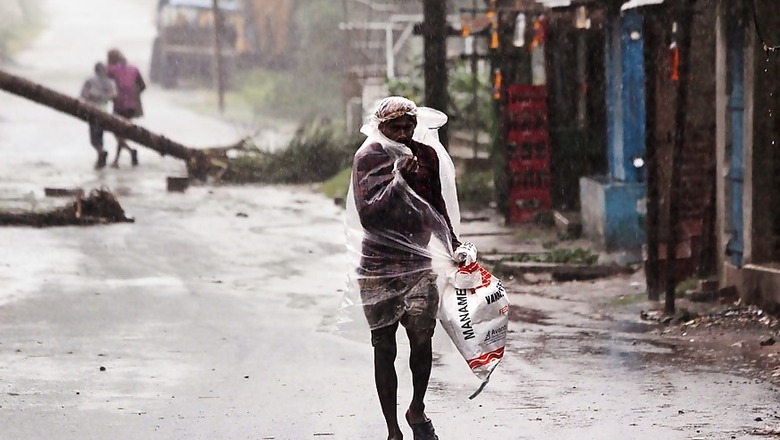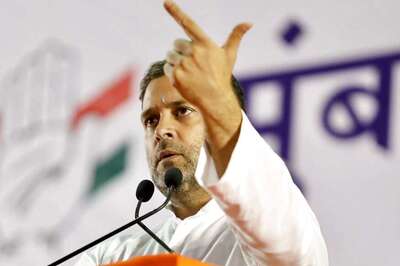
views
The extremely severe cyclone Amphan, packing winds of up to 190 kmph, on Wednesday rampaged through coastal Odisha and West Bengal, dumping heavy rain, swamping homes and farmland, and leaving at least three people dead, said officials.
While a man and a woman were reported killed when trees came crashing down on them in North 24 Parganas district of West Bengal, a 13-year-old girl died in a similar incident in adjoining Howrah. No casualties have yet been reported from Odisha.
But West Bengal Chief Minister Mamata Banerjee, monitoring the situation from the state secretariat, claimed at least 10-12 people lost their lives.
"Area after area has been ruined. I have experienced a war-like situation today. At least 10-12 people have died. Nandigram, Ramnagar....the two districts of North and South 24 Parganas are destroyed," she said.
With rains continuing, she said the hardest hits areas were not immediately accessible and authorities said they can only make a proper assessment of the destruction on Thursday morning.
"We are facing greater damage and devastation than COVID-19," Banerjee said, referring to the disease caused by the novel coronavirus that has so far killed 250 people in the state.
In neighbouring Bangladesh, officials said at least four people were killed, with power supplies cut off in some districts. Authorities there had shifted around 2.4 million people to more than 15,000 storm shelters this week. Bangladeshi officials also said they had moved hundreds of Rohingya refugees from Myanmar, living on a flood-prone island in the Bay of Bengal, to shelter.
After making landfall at 2.30 pm between Digha in Bengal and Hatiya island in Bangladesh, Amphan cut a swathe through the coastal areas, flattening fragile dwellings, uprooting trees and electric poles. At least 6.58 lakh people were evacuated in Bengal and Odisha before the cyclone struck.
"The forward sector of the wall cloud region is entering into land in West Bengal. The intensity of the cyclone near its centre as the landfall process started was recorded at 160-170 kmph, gusting to 190 kmph," said the weather department said.
National Disaster Response Force (NDRF) chief SN Pradhan said 20 teams of the federal force had already begun road clearing operations in Odisha, while the 19 units deployed in Bengal were shifting people to safety. Quoting figures made available by the two states, Pradhan said over 5 lakh people were evacuated in Bengal and more than 1.58 lakh in Odisha.
Television footage showed gigantic tidal waves crashing into a seawall in Digha, close to the landfall site. Thick sheets of rain blurred the vast coastline in the two states and surging waters engulfed mud-and-thatch houses, flattening them in a trice.
Heavy machinery was moved in to clear the roads blocked by falling trees. A video clip of an under-construction Kolkata skyscraper showed huge aluminium sheets flying like bird feathers in the air.
India Meteorological Department (IMD) Director General Mrityunjay Mohapatra said gale-strength winds speeding at 160-170 kmph were pounding South and North 24 Parganas and East Midnapore districts and could be gusting up to 185 kmph. He said the wall of the eye of the monster cyclone, the most explosive part of a cyclonic system, triggered copious rain in the three districts. The eye of the storm itself was 30 km in diameter, he said.
Mohapatra said the intensity of the rain and winds accompanying it could deceptively look like ebbing away briefly, but will surge afresh once the rear sector of the storm has reached the landmass.
The whole cyclonic system reached the landmass by 7 pm, before moving forward in fury.
Reports arriving in Kolkata from North and South 24 Parganas and East Midnapore said roofs of thatched houses were blown away, electric poles got twisted and hundreds of trees broken and uprooted. Streets and homes in low-lying areas of Kolkata were swamped with rainwater.
Alipore in central Kolkata recorded a massive 222 mm of rainfall and Dumdum 194 mm between 8 am and 8:30 pm. Even when the rain stopped in most parts of Kolkata after 9 pm, high-velocity winds continued to sweep the metropolis and its satellite towns. Almost the entire city was plunged into darkness since the evening as electric supply either got snapped due to rain and wind or was suspended as a precautionary measure. Cell-phone services were disrupted in many places.
Despite losing its force a bit since Tuesday, the storm, which was categorised as super cyclone at one point of time, left the two eastern states on edge as it hollered on its destructive path.
Banerjee said the enormity of the devastation will become clearer by Thursday when the storm will have passed over the state.
In Odisha, intense rainfall was recorded in several areas of Puri, Khurda, Jagatsinghpur, Cuttack, Kendrapara, Jajpur, Ganjam, Ganjam, Bhadrak and Balasore districts since Tuesday.
The rains and high-velocity winds ebbed away by late Wednesday night but not before causing massive damage to standing crops, plantations and infrastructure.
A tidal surge of up to five metres occured in North and South 24 Parganas and East Midnapore districts of Bengal, inundating vast tracts of land, officials said.
The turbulence will likely extend to Assam and Meghalaya, triggering heavy to very heavy rain on Thursday.
Mohapatra said since the time the depression formed over the Bay of Bengal on May 20 till the cyclone made the landfall, the IMDs predictions about the path it will take and the timing was accurate and helped the disaster response machinery strategise and execute the plans to minimise the damage effectively.
The cyclonic storm will get weaker while crossing over Nadia and Murshidabad in Bengal later on Wednesday night before entering Bangladesh as a deep depression and dissipating.
(With inputs from PTI)




















Comments
0 comment